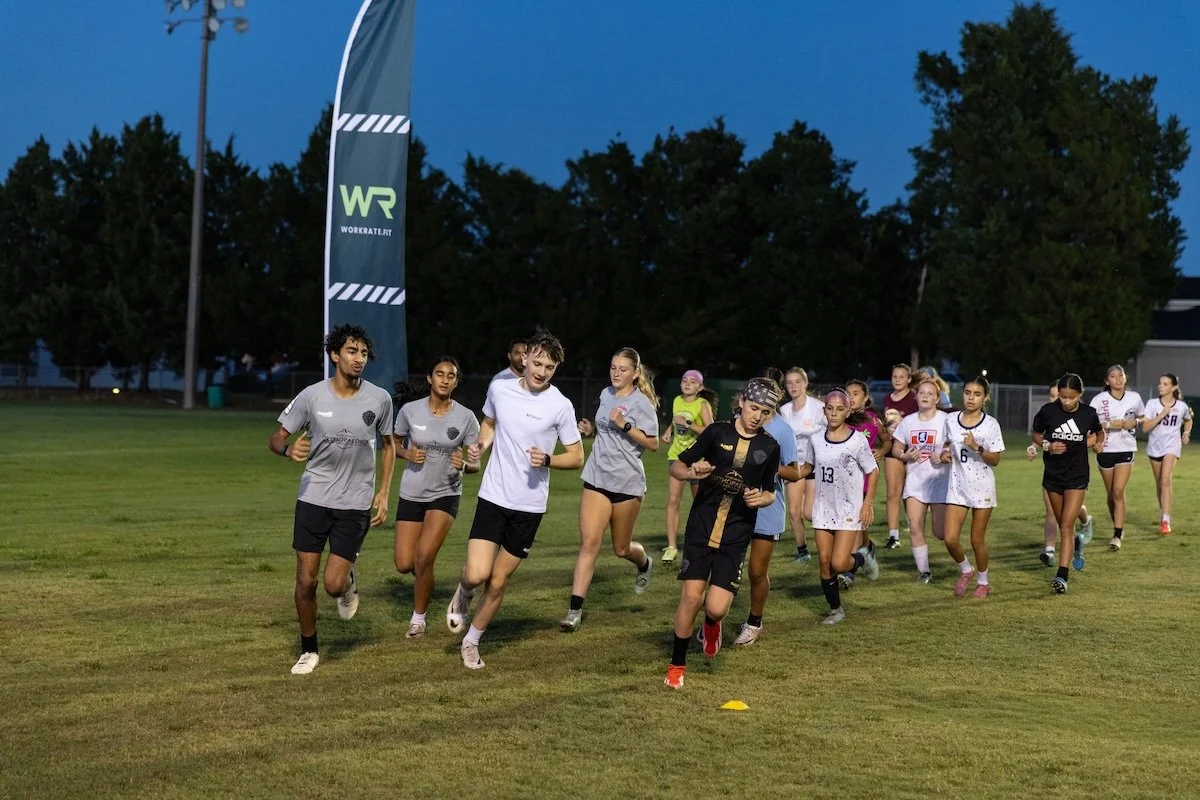Tampa Year 3: Lab-Quality Insights, On the Pitch
How ESPP24 became the breakthrough season—refining diagnostics, scaling impact, and delivering a physiological edge.
From Foundation to Breakthrough
In Years 1 and 2, Tampa laid the groundwork for a new approach to youth athlete development: diagnostics-first, precision-led, and coach-enabled. We validated the Running Efficiency Test (RET), introduced mobility screens into training rhythms, and aligned physical preparation with match calendars.
But 2024 was different.
This was the year we transitioned from testing as a tool to testing as a system. Powered by a new Garmin integration, anchored by the WorkRate Analytics Engine, and a full rebuild of the WorkRate platform by the team in Australia, Year 3 delivered clinical-grade insights in real-world conditions—no wires, no lab coat, no guesswork.
What We Deployed in Year 3
The WorkRate Scheduling Model (Refined, Not Replaced)
We didn’t overhaul the system—we reinforced what worked. With a full year of structured data behind us, ESPP23’s periodization model continued to guide testing and training rhythms. Aligned to the team’s competitive calendar, it helped ensure that diagnostics supported—not interrupted—performance.
We embedded a stress management decision system into this model, enabling coaches to adjust workloads based on both subjective (athlete-reported readiness) and objective (test results, Garmin metrics) feedback.
It remained simple, coach-led, and athlete-centered—giving staff the confidence to make high-stakes calls with data to back them up.
A Comprehensive Rebuild of the WorkRate Platform
The Australian team rebuilt the platform - the WorkRate Analytics Engine and the App frontend - incorporating the new Garmin data, improving the experience for the Athletes, and enabling the improved WorkRate system.
Garmin Integration: Unlocking the Full WorkRate Engine
Our collaboration with Garmin changed everything. We deployed:
Forerunner 55 and 165 wearables for continuous tracking
HRM-Fit and HRM-Pro Plus monitors for high-resolution heart rate and running dynamics
With Garmin’s infrastructure in place, we now had direct access to:
Real-time heart rate and HRV
Continuous sleep and recovery signals
Precision running dynamics: cadence, stride length, ground contact time, vertical oscillation
That data flowed directly into the WorkRate Analytics Engine, allowing for streamlined test analysis, recovery tracking, and program calibration—all visible to athletes, coaches, and staff.
RET Expansion with Running Dynamics
Garmin opened the door to a final, validated RET model. With access to raw sensor data, we began correlating form breakdown with fatigue markers. The RET, once a cadence-based test, evolved into a multidimensional diagnostic that tracked:
Cadence under load
GCT asymmetry and changes
Stride length degradation
Entrainment to external cueing
What began as a field test now offered lab-grade insights—and helped define individualized performance zones and readiness markers.
Physiological Feedback in Real Time
Garmin didn’t just replicate our Polar functionality—it expanded it dramatically with:
Real-time access to resting HR, HRV, and respiration patterns
Integrated sleep tracking and trend alerts
Live feedback during conditioning sessions
…we could monitor readiness, flag potential overtraining, and proactively manage workloads.
Physiology became a stream—not a snapshot.
Programming: From Platform to Wrist
For the first time, we pushed WorkRate conditioning programs directly to Garmin watches.
This allowed athletes to:
Train in precise Zone 2 windows
Receive real-time heart rate cues
Log and sync sessions automatically
Garmin Clipboard became the coaching dashboard. Watches became field-side assistants. Compliance and quality both improved.
Measurable Impact
We didn’t just observe better outcomes—we tracked them.
Running Efficiency Improved: Sensor-based metrics confirmed tighter movement signatures under fatigue.
Recovery Awareness Increased: Athletes began connecting soreness, sleep, and HRV—adjusting prep accordingly.
Engagement Stayed High: From middle schoolers to senior players, athletes explored their own data via Garmin Connect and the WorkRate App. They asked questions. They checked their progress. They came to sessions more prepared—mentally and physically.
Scaling the Lab Experience
We scaled sound and space, too. Six JBL speakers replaced the original four, extending cue fidelity across wider training zones. This made a big difference, especially with younger athletes—who tend to race each other, ignore cadence cues, or lose tempo.
By expanding the auditory field, we preserved diagnostic integrity—even as group size grew.
What We Learned
Running efficiency is measurable in the wild using wearable sensors and form diagnostics.
Real-time physiological data enhances decision-making and personalizes training at scale.
Youth athletes thrive with structure—when it’s paired with technology that reflects their reality.
The RET didn’t just measure running. It measured adaptation.
The wearables didn’t just log metrics. They built awareness.
The coaches didn’t just run tests. They ran a system.
The Takeaway
ESPP24 was the breakthrough year.
We validated a full-stack diagnostic protocol to measure—and improve—running efficiency.
We embedded conditioning, feedback, and recovery into one ecosystem.
We proved that lab-quality data can live on the pitch.
And in doing so, we built the foundation of the WorkRate platform as it exists today.
Powered by Garmin. Driven by data. Led by athletes.





